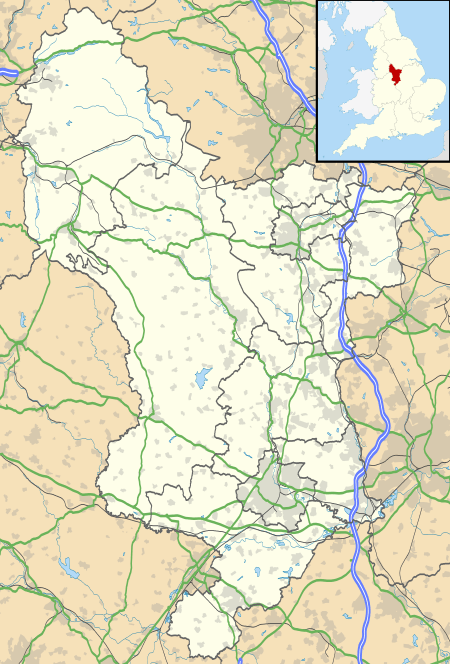Great Longstone
Great Longstone with Little Longstone is one of two villages in the local government district of Derbyshire Dales in Derbyshire, England. The population (including Hassop and Rowland, but not Little Longstone) as taken at the 2011 Census was 843.[1]
| Great Longstone | |
|---|---|
 Main Street | |
 Great Longstone Location within Derbyshire | |
| Population | 843 (2011) |
| OS grid reference | SK210720 |
| District | |
| Shire county | |
| Region | |
| Country | England |
| Sovereign state | United Kingdom |
| Post town | BAKEWELL |
| Postcode district | DE45 |
| Dialling code | 01629 |
| Police | Derbyshire |
| Fire | Derbyshire |
| Ambulance | East Midlands |
| UK Parliament | |
History
A place called Longsdune was mentioned in the Domesday Book as belonging to Henry de Ferrers[2] and being worth thirty shillings; this is considered to be Great Longstone.[3]
The church of St Giles in Great Longstone dates from the 13th century. A medieval cross stands in the churchyard, and the head of a cross is built into the wall of the vestry.[4]
The manor house, Longstone Hall, has its origins in the following century, but was rebuilt in the mid-18th century. That century was one of prosperity, with lead-mining and shoemaking. There are two public houses in the main village: The Crispin Inn, named after St Crispin, the patron saint of shoemakers, and The White Lion.
The manors of Great and Little Longstone passed through many hands over the years. Walter Blount, Lord Mountjoy, was Lord of the Manor on his death in 1474, when the lordship passed to Robert Shakerley[5] and his wife Margaret, daughter and heiress of Roger Levett.[6] The two families' coats of arms adorn the church of St Giles. In subsequent years, Shakerley descendants sold the manor to Elizabeth Talbot, Countess of Shrewsbury.[7]
A market cross stands on the village green.[4]
Little Longstone, further west, has a 17th-century manor house and still has its village stocks.
To the north is Longstone Edge, a limestone ridge some 1,300 feet (400 m) in height, on an upfolding of the Derbyshire limestone known as the Longstone Anticline. It has been, and is, intensively quarried for galena, fluorspar, barytes and, more controversially, limestone. Since Longstone Edge is a noted beauty spot and is within the Peak District National Park there is strong local pressure for quarrying to stop altogether. Some of the quarrying is strictly controlled by the Peak District National Park Authority, which has been conducting a lengthy legal battle to try to stop other quarries that are operating outside the authority's guidelines. Further north is the White Cliff, where the exposed limestone contains fossilised corals.
There was a railway station, built by the Midland Railway in 1863 when it extended the Manchester, Buxton, Matlock and Midlands Junction Railway towards Buxton. Originally known as "Longstone", in 1913 it was renamed "Great Longstone for Ashford" (Ashford-in-the-Water). It closed in 1962, but the building, designed to match the nearby Thornbridge Hall, survives as a domestic residence, and the trackbed through the station is part of the 8.5-mile (13.7 km) Monsal Trail, a walk and cycleway.

References
- "Civil Parish population 2011". Neighbourhood Statistics. Office for National Statistics. Retrieved 24 March 2016.
- Henry was given a large number of manors in Derbyshire including Doveridge, Spondon, Pilsbury and Breadsall.
- Williams, Ann; Martin, G.H. (2003). Domesday book : a complete translation (Alecto historical ed.). London [u.a.]: Penguin Books. p. 748. ISBN 0-14-143994-7.
- Neville T. Sharpe, Crosses of the Peak District (Landmark Collectors Library, 2002)
- Robert Shakerley was of the cadet branch of the Shakerley family of Cheshire.
- Shakerley of Longstone, Magna Britannia, Vol. 5, Daniel and Samuel Lysons, 1817, British History Online
- Cox, John Charles (1877). Notes on the Churches of Derbyshire: The hundreds of the High Peak and Wirksworth. 1877. Palmer and Edmunds. p. 99. Retrieved 7 May 2015.
shakerley levett.
External links
| Wikimedia Commons has media related to Great Longstone. |